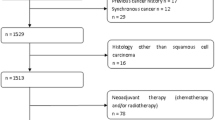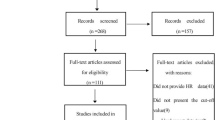Abstract
Objective
To determine whether tumor length provides additional prognostic information beyond traditional TNM staging alone.
Methods
A retrospective review was conducted of 356 patients with stage I–III esophageal cancer treated with curative intent at the University of Washington between 1995 and 2010. All patients had esophagoduodenoscopy prior to treatment. Multivariate Cox models were performed to evaluate the impact of tumor length on mortality as both a continuous and binary variable (≤3 and >3 cm), controlling for stage, histology, treatment, gender, and age.
Results
Among all patients, each increasing centimeter of tumor involvement was associated with a 13 % increased risk of mortality (hazard ratio (HR) = 1.13, p < 0.001). The hazard ratio for death was 1.22 (p = 0.009) for stage I patients, 1.12 (p = 0.146) for stage II patients, and 1.08 (p = 0.095) for stage III patients. When dichotomizing tumor length among all patients, tumors >3.0 cm were not associated with poorer survival compared with tumors ≤3.0 cm (HR = 1.16, p = 0.466). Among the stage I population, the adjusted relative risk of mortality for patients with tumors >3 cm is 2.63 with a trend towards significance (p = 0.089). No increased risk of mortality was observed among the stage II and III populations.
Conclusion
The increased risk of mortality associated with longer tumors, with the effect largely influenced by the stage I patients, helps generate a hypothesis that tumor length may have greater prognostic significance in stage I patients than in stage II/III patients. Our findings suggest that it may be helpful to include tumor length in esophageal cancer staging guidelines.



Similar content being viewed by others
References
Meredith KL, Weber JM, Turaga KK et al (2010) Pathologic response after neoadjuvant therapy is a major determinant of survival in patients with esophageal cancer. Ann Surg Oncol 17(4):1159–1167
Korst RJ, Kansler AL, Port JL et al (2006) Downstaging of T or N predicts long-term survival after preoperative chemotherapy and radical resection for esophageal carcinoma. Ann Thorac Surg 82:480–484
van Meerten E, van der Gaast A, Tilanus HW et al (2009) Pathological analysis after neoadjuvant chemoradiotherapy for esophageal carcinoma: the Rotterdam experience. J Surg Oncol 100:32–37
Griffiths EA, Brummell Z, Gorthi G, Pritchard SA, Welch IM (2006) Tumor length as a prognostic factor in esophageal malignancy: univariate and multivariate survival analyses. J Surg Oncol 93:258–267
Katrin MS, Bryan HB, Smither BM et al (2011) Survival after neo-adjuvant chemotherapy or chemoradiotherapy for resectable esophageal adenocarcinoma: an updated meta-analysis. Lancet Oncol 12:681–692
Wang B, Goan Y, Hsu P et al (2011) Tumor length as a prognostic factor in esophageal squamous cell carcinoma. Ann Thorac Surg 91:887–893
Eloubedi MA, Desmond R, Arguedas M et al (2002) Prognostic factors for the survival of patients with esophageal carcinoma in the U.S. Cancer 95:1434–1443
Edge S, Byrd R, Compton C, et al (2009) AJCC cancer staging manual, 7th edn. Springer
NCCN guidelines. http://www.nccn.org/professionals/physician_gls/pdf/esophageal.pdf. Accessed 12 Sept 2012
Van Vliet EP, Heijenbrok-Kal MH, Hunink MG, et al (2008) Staging investigations for oesophageal cancer: a meta-analysis. Br J Cancer 98(547–57)
Hsu WH, Hsu PK, Wang SJ et al (2009) Positron emission tomography-computed tomography in predicting locoregional invasion in esophageal squamous cell carcinoma. Ann Thorac Surg 87:1564–1568
Bergman JJ (2006) The endoscopic diagnosis and staging of oesophageal adenocarcinoma. Best Pract Res Clin Gastroenterol 20(5):843–866
Enzinger PC, Mayer RJ (2003) Esophageal cancer. N Engl J Med 349(23):2241–2252
Das A, Chak A, Sivak MV Jr et al (2006) Endoscopic ultrasonography and prognosis of esophageal cancer. Clin Gastroenterol Hepatol 4(6):695–700
Lerut T, Coosemans W, Decker G et al (2006) Diagnosis and therapy in advanced cancer of the esophagus and the gastroesophageal junction. Curr Opin Gastroenterol 22(4):437–441
Kwok H, Bissett IP, Hill GL (2000) Preoperative staging of rectal cancer. Int J Colorectal Dis 15(1):9–20
Waizer A, Powsner E, Russo I et al (1991) Prospective comparative study of magnetic resonance imaging versus transrectal ultrasound for preoperative staging and follow-up of rectal cancer. Preliminary report. Dis Colon Rectum 34(12):1068–1072
Salminen JT, Farkkila MA, Ramo OJ et al (1999) Endoscopic ultrasonography in the preoperative staging of adenocarcinoma of the distal esophagus and esophagogastric junction. Scand J Gastroenterol 34:1178–1182
Fockens P, Van den Brande JH, van Dullemen HM et al (1996) Endosonographic T-staging of esophageal carcinoma: a learning curve. Gastrointest Endosc 44:58–62
Schlick T, Heintz A, Junginger T (1999) The examiner’s learning effect and its influence on the quality of endoscopic ultrasonography in carcinoma of the esophagus and gastric cardia. Surg Endosc 13:894–898
Rice TW, Zuccaro GJ, Adelstein DJ et al (1998) Esophageal carcinoma: depth of tumor invasion is predictive of regional lymph node status. Ann Thorac Surg 65:787–792
Lizuka T, Isono K, Kakegawa T, Watanabe H (1989) Parameters linked to ten-year survival in Japan of resected esophageal carcinoma. Japanese Committee for Registration of Esophageal Carcinoma Cases. Chest 96:1005–1011
Sobin LH, Hermanek P, Hutter RV (1988) TNM classification of malignant tumors: a comparison between the new (1987) and the old editions. Cancer 61:2310–2314
Conflict of interest
Camille Berriochoa, Daniel Hibbard, Mary Morcos, Aasthaa Bansal, Bryan Comstock, Brant Oelschlager, Carlos Pellegrini, Veena Shankaran, Jing Zeng, and Shilpen Patel declare that they have no conflict of interest. Additionally, we would like to emphasize that there were neither financial grants nor funding sources that contributed to this research. Authors do not have industrial links or affiliations.
Ethical standard statement
All procedures followed were in accordance with the ethical standards of the responsible committee on human experimentation (institutional and national) and with the Helsinki Declaration of 1975, as revised in 2008.
Author information
Authors and Affiliations
Corresponding author
Rights and permissions
About this article
Cite this article
Berriochoa, C.A., Hibbard, D., Morcos, M. et al. Tumor length as a prognostic factor in esophageal cancer management. J Radiat Oncol 4, 71–77 (2015). https://doi.org/10.1007/s13566-014-0179-y
Received:
Accepted:
Published:
Issue Date:
DOI: https://doi.org/10.1007/s13566-014-0179-y




